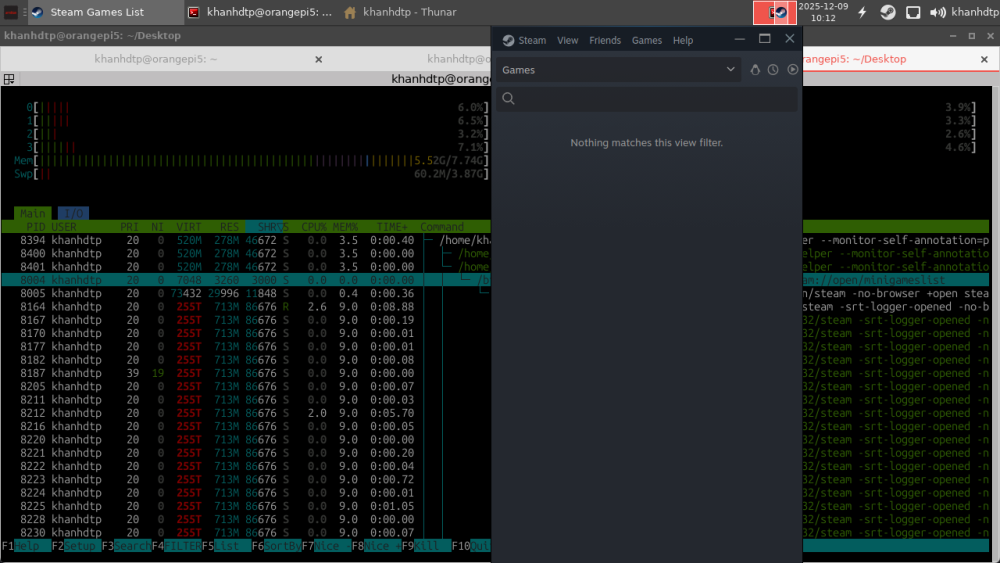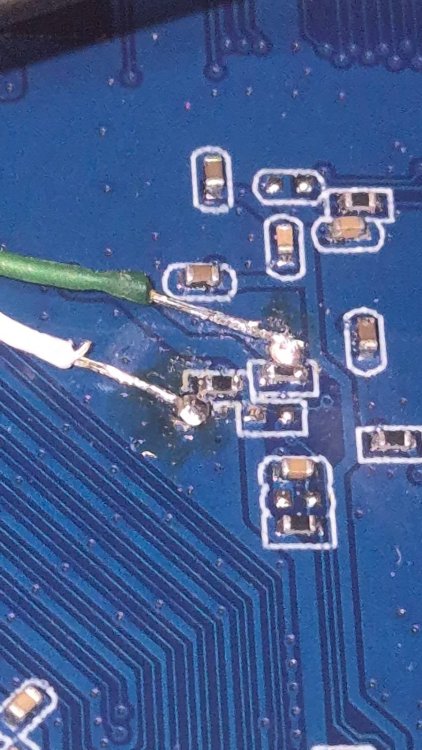All Activity
- Past hour
-
So, after 10 days of struggling with flashing the device and hundreds of flashing methods, I think the Armbian firmware for the Luckfox Lyra Ultra W DOESN'T WORK. Unfortunately, the firmware developer responded once here and hasn't responded since. I don't know if he has this board or not. After flashing the device in various ways, I only have two different boot logs (I captured the logs using TTL-USB since the network doesn't work on the device). LOG1 ▒DDR d27ac532c4 typ 25/03/11-14:46:28,fwver: v1.06 tREFI:4x, sr_idle:93, pd_idle:13 PHY drv:clk:40,ca:48,DQ:40,odt:240 vrefinner:50%, vrefout:50% dram drv:40,odt:120 sr_dq:0, sr_ca:0, sr_clk:0 rg:0x6-0x1-0x2, 0x3e-0x0-0x2,status:a007 rdtrn:0x11-0x2e-0x4b(0x3a) wrtrn:0x3-0x21-0x3f(0x3c) DDR3, 750MHz BW=16 Col=10 Bk=8 CS0 Row=15 CS=1 Size=512MB out U-Boot SPL 2025.10-rc4_armbian-2025.10-rc4-S0b8e-P474e-H4702-V3bf2-Bbf55-R448a (Dec 04 2025 - 04:42:05 +0000) Trying to boot from MMC1 ## Checking hash(es) for config config-1 ... OK ## Checking hash(es) for Image op-tee ... sha256+ OK ## Checking hash(es) for Image u-boot ... sha256+ OK ## Checking hash(es) for Image fdt-1 ... sha256+ OK I/TC: I/TC: OP-TEE version: 3.13.0-958-g46dcf51e88a #chenjh (gcc version 10.2.1 20201103 (GNU Toolchain for the A-profile Architecture 10.2-2020.11 (arm-10.16))) #2 Thu Mar 6 10:17:27 CST 2025 arm, fwver: v2.10 I/TC: Status: cluster=0xc00, core=0xe100, bootcpu=0 I/TC: Next entry point address: 0x00100000 I/TC: OP-TEE memory size: TEEOS 0x5e000 TA 0x1000 SHM 0x1000 I/TC: Primary CPU initializing I/TC: Primary CPU switching to normal world boot ns16550_serial serial@ff0a0000: pinctrl_select_state_full: uclass_get_device_by_phandle_id: err=-19 U-Boot 2025.10-rc4_armbian-2025.10-rc4-S0b8e-P474e-H4702-V3bf2-Bbf55-R448a (Dec 04 2025 - 04:42:05 +0000) Model: Luckfox Lyra Ultra SoC: RK3506B DRAM: 512 MiB (total 511 MiB) Core: 85 devices, 30 uclasses, devicetree: separate MMC: mmc@ff480000: 0 Loading Environment from nowhere... OK In: serial@ff0a0000 Out: serial@ff0a0000 Err: serial@ff0a0000 rockchip_dnl_key_pressed: no saradc device found Net: eth0: ethernet@ff4d0000 Hit any key to stop autoboot: 0 Scanning for bootflows in all bootdevs Seq Method State Uclass Part Name Filename --- ----------- ------ -------- ---- ------------------------ ---------------- Scanning global bootmeth 'efi_mgr': Cannot persist EFI variables without system partition 0 efi_mgr ready (none) 0 <NULL> ** Booting bootflow '<NULL>' with efi_mgr Loading Boot0000 'mmc 0' failed EFI boot manager: Cannot load any image Boot failed (err=-14) Scanning bootdev 'mmc@ff480000.bootdev': 1 script ready mmc 1 mmc@ff480000.bootdev.part /boot/boot.scr ** Booting bootflow 'mmc@ff480000.bootdev.part_1' with script Boot script loaded from mmc 0 234 bytes read in 3 ms (76.2 KiB/s) 11012819 bytes read in 889 ms (11.8 MiB/s) 5713472 bytes read in 463 ms (11.8 MiB/s) Failed to load '/boot/dtb/rockchip/rk3506b-luckfox-lyra-ultra.dtb' libfdt fdt_check_header(): FDT_ERR_BADMAGIC No FDT memory address configured. Please configure the FDT address via "fdt addr <address>" command. Aborting! Failed to load '/boot/dtb/overlay/-fixup.scr' Kernel image @ 0x2080000 [ 0x000000 - 0x572e40 ] ## Loading init Ramdisk from Legacy Image at 02800000 ... Image Name: uInitrd Image Type: ARM Linux RAMDisk Image (gzip compressed) Data Size: 11012755 Bytes = 10.5 MiB Load Address: 00000000 Entry Point: 00000000 Verifying Checksum ... OK ERROR: Did not find a cmdline Flattened Device Tree Could not find a valid device tree Boot failed (err=-14) Unknown uclass 'nvme' in label Unknown uclass 'scsi' in label dwc2_usb usb@ff780000: Can't get reset: -2 USB DWC2 Bus usb@ff780000: 3 USB Device(s) found Scanning bootdev 'ethernet@ff4d0000.bootdev': BOOTP broadcast 1 BOOTP broadcast 2 BOOTP broadcast 3 BOOTP broadcast 4 BOOTP broadcast 5 BOOTP broadcast 6 BOOTP broadcast 7 BOOTP broadcast 8 Retry time exceeded; starting again Scanning bootdev 'ethernet@ff4d0000.bootdev': BOOTP broadcast 1 BOOTP broadcast 2 BOOTP broadcast 3 BOOTP broadcast 4 BOOTP broadcast 5 BOOTP broadcast 6 BOOTP broadcast 7 Retry time exceeded; starting again No more bootdevs --- ----------- ------ -------- ---- ------------------------ ---------------- (2 bootflows, 2 valid) => <INTERRUPT> => LOG2 DDR d27ac532c4 typ 25/03/11-14:46:28,fwver: v1.06 tREFI:4x, sr_idle:93, pd_idle:13 SRX get rd_skew=0x2e, wr_skew=0x21 PHY drv:clk:40,ca:48,DQ:40,odt:240 vrefinner:50%, vrefout:50% dram drv:40,odt:120 sr_dq:0, sr_ca:0, sr_clk:0 rg:0x5-0x1-0x2, 0x3b-0x0-0x2,status:a007 DDR3, 750MHz BW=16 Col=10 Bk=8 CS0 Row=15 CS=1 Size=512MB out U-Boot SPL 2025.10-rc4_armbian-2025.10-rc4-S0b8e-P474e-H4702-V3bf2-Bbf55-R448a (Dec 04 2025 - 04:42:05 +0000) Trying to boot from MMC1 ## Checking hash(es) for config config-1 ... OK ## Checking hash(es) for Image op-tee ... sha256+ OK ## Checking hash(es) for Image u-boot ... sha256+ OK ## Checking hash(es) for Image fdt-1 ... sha256+ OK I/TC: I/TC: OP-TEE version: 3.13.0-958-g46dcf51e88a #chenjh (gcc version 10.2.1 20201103 (GNU Toolchain for the A-profile Architecture 10.2-2020.11 (arm-10.16))) #2 Thu Mar 6 10:17:27 CST 2025 arm, fwver: v2.10 I/TC: Status: cluster=0xc00, core=0xe100, bootcpu=0 I/TC: Next entry point address: 0x00100000 I/TC: OP-TEE memory size: TEEOS 0x5e000 TA 0x1000 SHM 0x1000 I/TC: Primary CPU initializing I/TC: Primary CPU switching to normal world boot ns16550_serial serial@ff0a0000: pinctrl_select_state_full: uclass_get_device_by_phandle_id: err=-19 U-Boot 2025.10-rc4_armbian-2025.10-rc4-S0b8e-P474e-H4702-V3bf2-Bbf55-R448a (Dec 04 2025 - 04:42:05 +0000) Model: Luckfox Lyra Ultra SoC: RK3506B DRAM: 512 MiB (total 511 MiB) Core: 85 devices, 30 uclasses, devicetree: separate MMC: mmc@ff480000: 0 Loading Environment from nowhere... OK In: serial@ff0a0000 Out: serial@ff0a0000 Err: serial@ff0a0000 rockchip_dnl_key_pressed: no saradc device found Net: eth0: ethernet@ff4d0000 Hit any key to stop autoboot: 0 Scanning for bootflows in all bootdevs Seq Method State Uclass Part Name Filename --- ----------- ------ -------- ---- ------------------------ ---------------- Scanning global bootmeth 'efi_mgr': Cannot persist EFI variables without system partition 0 efi_mgr ready (none) 0 <NULL> ** Booting bootflow '<NULL>' with efi_mgr Loading Boot0000 'mmc 0' failed EFI boot manager: Cannot load any image Boot failed (err=-14) Scanning bootdev 'mmc@ff480000.bootdev': 1 script ready mmc 1 mmc@ff480000.bootdev.part /boot/boot.scr ** Booting bootflow 'mmc@ff480000.bootdev.part_1' with script Boot script loaded from mmc 0 185 bytes read in 3 ms (59.6 KiB/s) 10866313 bytes read in 878 ms (11.8 MiB/s) 5694528 bytes read in 462 ms (11.8 MiB/s) 545230 bytes read in 48 ms (10.8 MiB/s) Working FDT set to 1e00000 Failed to load '/boot/dtb/overlay/rockchip-fixup.scr' Kernel image @ 0x2080000 [ 0x000000 - 0x56e440 ] ## Loading init Ramdisk from Legacy Image at 02800000 ... Image Name: uInitrd Image Type: ARM Linux RAMDisk Image (gzip compressed) Data Size: 10866249 Bytes = 10.4 MiB Load Address: 00000000 Entry Point: 00000000 Verifying Checksum ... OK ## Flattened Device Tree blob at 01e00000 Booting using the fdt blob at 0x1e00000 Working FDT set to 1e00000 Loading Ramdisk to 1c1a3000, end 1cbffe49 ... OK Loading Device Tree to 1ce28000, end 1cf15fff ... OK Working FDT set to 1ce28000 Starting kernel ... I/TC: Secondary CPU 1 initializing I/TC: Secondary CPU 1 switching to normal world boot I/TC: Secondary CPU 2 initializing I/TC: Secondary CPU 2 switching to normal world boot E/TC:1 plat_shm_get_page_num:386 plat_shm_get_page_num: type 6 alloc is not supported Loading, please wait... Starting systemd-udevd version 257.9-1~deb13u1 Begin: Loading essential drivers ... done. Begin: Running /scripts/init-premount ... done. Begin: Mounting root file system ... Begin: Running /scripts/local-top ... done. Begin: Running /scripts/local-premount ... Scanning for Btrfs filesystems done. Begin: Will now check root file system ... fsck from util-linux 2.41 [/sbin/fsck.ext4 (1) -- /dev/mmcblk0p1] fsck.ext4 -a -C0 /dev/mmcblk0p1 armbi_root: clean, 54290/91584 files, 334609/366336 blocks done. done. Begin: Running /scripts/local-bottom ... done. Begin: Running /scripts/init-bottom ... done. Welcome to Armbian-unofficial 26.02.0-trunk trixie! [ OK ] Created slice system-modprobe.slice - Slice /system/modprobe. [ OK ] Created slice system-serial\x2dget…slice - Slice /system/serial-getty. [ OK ] Created slice user.slice - User and Session Slice. [ OK ] Started systemd-ask-password-conso…equests to Console Directory Watch. [ OK ] Started systemd-ask-password-wall.…d Requests to Wall Directory Watch. Expecting device dev-ttyFIQ0.device - /dev/ttyFIQ0... Expecting device dev-ttyS2.device - /dev/ttyS2... [ OK ] Reached target paths.target - Path Units. [ OK ] Reached target remote-fs.target - Remote File Systems. [ OK ] Reached target slices.target - Slice Units. [ OK ] Reached target swap.target - Swaps. [ OK ] Listening on syslog.socket - Syslog Socket. [ OK ] Listening on systemd-creds.socket - Credential Encryption/Decryption. [ OK ] Listening on systemd-initctl.socke…- initctl Compatibility Named Pipe. [ OK ] Listening on systemd-journald-dev-…socket - Journal Socket (/dev/log). [ OK ] Listening on systemd-journald.socket - Journal Sockets. [ OK ] Listening on systemd-networkd.socket - Network Service Netlink Socket. [ OK ] Listening on systemd-udevd-control.socket - udev Control Socket. [ OK ] Listening on systemd-udevd-kernel.socket - udev Kernel Socket. Mounting dev-mqueue.mount - POSIX Message Queue File System... Mounting run-lock.mount - Legacy Locks Directory /run/lock... Mounting sys-kernel-debug.mount - Kernel Debug File System... Starting fake-hwclock-load.service - Restore the current clock... Starting keyboard-setup.service - Set the console keyboard layout... Starting kmod-static-nodes.service…eate List of Static Device Nodes... Starting modprobe@configfs.service - Load Kernel Module configfs... Starting modprobe@drm.service - Load Kernel Module drm... Starting modprobe@efi_pstore.servi… - Load Kernel Module efi_pstore... Starting modprobe@fuse.service - Load Kernel Module fuse... Starting systemd-modules-load.service - Load Kernel Modules... Starting systemd-network-generator…k units from Kernel command line... Starting systemd-udev-load-credent…Load udev Rules from Credentials... Starting systemd-udev-trigger.service - Coldplug All udev Devices... [ OK ] Mounted dev-mqueue.mount - POSIX Message Queue File System. [ OK ] Mounted run-lock.mount - Legacy Locks Directory /run/lock. [ OK ] Mounted sys-kernel-debug.mount - Kernel Debug File System. [ OK ] Finished fake-hwclock-load.service - Restore the current clock. [ OK ] Finished kmod-static-nodes.service…Create List of Static Device Nodes. [ OK ] Finished modprobe@configfs.service - Load Kernel Module configfs. [ OK ] Finished modprobe@drm.service - Load Kernel Module drm. [ OK ] Finished modprobe@efi_pstore.service - Load Kernel Module efi_pstore. [ OK ] Finished modprobe@fuse.service - Load Kernel Module fuse. [ OK ] Finished systemd-modules-load.service - Load Kernel Modules. [ OK ] Finished systemd-udev-load-credent…- Load udev Rules from Credentials. [ OK ] Finished systemd-network-generator…ork units from Kernel command line. [ OK ] Reached target network-pre.target - Preparation for Network. Mounting sys-kernel-config.mount - Kernel Configuration File System... Starting systemd-remount-fs.servic…unt Root and Kernel File Systems... Starting systemd-sysctl.service - Apply Kernel Variables... Starting systemd-tmpfiles-setup-de… Device Nodes in /dev gracefully... [ OK ] Finished keyboard-setup.service - Set the console keyboard layout. [ OK ] Mounted sys-kernel-config.mount - Kernel Configuration File System. [ OK ] Finished systemd-sysctl.service - Apply Kernel Variables. [ OK ] Finished systemd-remount-fs.servic…mount Root and Kernel File Systems. Starting systemd-random-seed.service - Load/Save OS Random Seed... [ OK ] Finished systemd-tmpfiles-setup-de…ic Device Nodes in /dev gracefully. Starting systemd-sysusers.service - Create System Users... [ OK ] Finished systemd-sysusers.service - Create System Users. Starting systemd-resolved.service - Network Name Resolution... Starting systemd-timesyncd.service - Network Time Synchronization... Starting systemd-tmpfiles-setup-de…eate Static Device Nodes in /dev... [ OK ] Finished systemd-udev-trigger.service - Coldplug All udev Devices. [ OK ] Finished systemd-tmpfiles-setup-de…Create Static Device Nodes in /dev. [ OK ] Reached target local-fs-pre.target…Preparation for Local File Systems. Starting systemd-udevd.service - R…ager for Device Events and Files... Mounting tmp.mount - /tmp... [ OK ] Mounted tmp.mount - /tmp. [ OK ] Reached target local-fs.target - Local File Systems. [ OK ] Listening on systemd-sysext.socket… System Extension Image Management. Starting armbian-zram-config.service - Armbian ZRAM config... Starting console-setup.service - Set console font and keymap... [ OK ] Started systemd-timesyncd.service - Network Time Synchronization. [ OK ] Reached target time-set.target - System Time Set. [ OK ] Started systemd-udevd.service - Ru…anager for Device Events and Files. Starting systemd-networkd.service - Network Configuration... [ OK ] Found device dev-ttyFIQ0.device - /dev/ttyFIQ0. [ OK ] Listening on systemd-rfkill.socket…ll Switch Status /dev/rfkill Watch. Starting systemd-rfkill.service - Load/Save RF Kill Switch Status... [ OK ] Finished systemd-random-seed.service - Load/Save OS Random Seed. Starting systemd-machine-id-commit…ave Transient machine-id to Disk... [ OK ] Started systemd-rfkill.service - Load/Save RF Kill Switch Status. [ OK ] Started systemd-networkd.service - Network Configuration. Starting systemd-networkd-persiste…tent Storage in systemd-networkd... [ OK ] Finished systemd-machine-id-commit… Save Transient machine-id to Disk. [ OK ] Started systemd-resolved.service - Network Name Resolution. [ OK ] Reached target nss-lookup.target - Host and Network Name Lookups. [ OK ] Finished systemd-networkd-persiste…istent Storage in systemd-networkd. [ OK ] Finished armbian-zram-config.service - Armbian ZRAM config. Starting armbian-ramlog.service - Armbian memory supported logging... [ OK ] Finished armbian-ramlog.service - Armbian memory supported logging. Starting systemd-journald.service - Journal Service... [ OK ] Started systemd-journald.service - Journal Service. Starting systemd-journal-flush.ser…sh Journal to Persistent Storage... [ OK ] Finished systemd-journal-flush.ser…lush Journal to Persistent Storage. Starting systemd-tmpfiles-setup.se…ate System Files and Directories... [ OK ] Finished systemd-tmpfiles-setup.se…reate System Files and Directories. Starting ldconfig.service - Rebuild Dynamic Linker Cache... Starting systemd-journal-catalog-u…ervice - Rebuild Journal Catalog... [ OK ] Finished systemd-journal-catalog-u….service - Rebuild Journal Catalog. [ OK ] Finished ldconfig.service - Rebuild Dynamic Linker Cache. Starting systemd-update-done.service - Update is Completed... [ OK ] Finished systemd-update-done.service - Update is Completed. [ OK ] Reached target sysinit.target - System Initialization. [ OK ] Started apt-daily.timer - Daily apt download activities. [ OK ] Started apt-daily-upgrade.timer - …y apt upgrade and clean activities. [ OK ] Started dpkg-db-backup.timer - Daily dpkg database backup timer. [ OK ] Started e2scrub_all.timer - Period…Metadata Check for All Filesystems. [ OK ] Started fake-hwclock-save.timer - Periodically save current clock. [ OK ] Started fstrim.timer - Discard unused filesystem blocks once a week. [ OK ] Started logrotate.timer - Daily rotation of log files. [ OK ] Started man-db.timer - Daily man-db regeneration. [ OK ] Started systemd-tmpfiles-clean.tim…y Cleanup of Temporary Directories. [ OK ] Reached target timers.target - Timer Units. [ OK ] Listening on dbus.socket - D-Bus System Message Bus Socket. [ OK ] Listening on sshd-unix-local.socke…temd-ssh-generator, AF_UNIX Local). [ OK ] Listening on systemd-hostnamed.socket - Hostname Service Socket. [ OK ] Reached target sockets.target - Socket Units. Starting armbian-hardware-monitor.…ce - Armbian hardware monitoring... Starting armbian-hardware-optimize… - Armbian hardware optimization... Starting armbian-led-state.service - Armbian leds state... Starting armbian-resize-filesystem…vice - Armbian filesystem resize... [ OK ] Finished armbian-hardware-monitor.…vice - Armbian hardware monitoring. [ OK ] Finished armbian-led-state.service - Armbian leds state. [ OK ] Finished armbian-hardware-optimize…ce - Armbian hardware optimization. [ OK ] Finished armbian-resize-filesystem…ervice - Armbian filesystem resize. [ OK ] Reached target basic.target - Basic System. [ OK ] Started cron.service - Regular background program processing daemon. Starting dbus.service - D-Bus System Message Bus... Starting e2scrub_reap.service - Re…ne ext4 Metadata Check Snapshots... Starting rsyslog.service - System Logging Service... Starting systemd-logind.service - User Login Management... [ OK ] Started dbus.service - D-Bus System Message Bus. Starting wpa_supplicant.service - WPA supplicant... [ OK ] Started wpa_supplicant.service - WPA supplicant. [ OK ] Reached target network.target - Network. Starting rc-local.service - /etc/rc.local Compatibility... Starting ssh.service - OpenBSD Secure Shell server... Starting systemd-user-sessions.service - Permit User Sessions... [ OK ] Started rsyslog.service - System Logging Service. [ OK ] Started rc-local.service - /etc/rc.local Compatibility. [ OK ] Finished systemd-user-sessions.service - Permit User Sessions. [ OK ] Started serial-getty@ttyFIQ0.service - Serial Getty on ttyFIQ0. [ OK ] Started systemd-logind.service - User Login Management. [ OK ] Started ssh.service - OpenBSD Secure Shell server. [ OK ] Started armbian-firstrun.service - Armbian first run tasks. [ OK ] Created slice system-getty.slice - Slice /system/getty. [ OK ] Finished e2scrub_reap.service - Re…line ext4 Metadata Check Snapshots. [ OK ] Finished console-setup.service - Set console font and keymap. luckfox-lyra-ultra-w login: root (automatic login) Waiting for system to finish booting ... Stopping ssh.service - OpenBSD Secure Shell server... [ OK ] Stopped ssh.service - OpenBSD Secure Shell server. Starting ssh.service - OpenBSD Secure Shell server... [ OK ] Started ssh.service - OpenBSD Secure Shell server. Stopping ssh.service - OpenBSD Secure Shell server... [ OK ] Stopped ssh.service - OpenBSD Secure Shell server. Starting ssh.service - OpenBSD Secure Shell server... [ OK ] Started ssh.service - OpenBSD Secure Shell server. As you can see from the logs, there is a problem with loading either boot or rk3506b-luckfox-lyra-ultra.dtb
- Today
-

Gaming experience with Orange Pi 5 (RK3588) on Armbian
晓飞丁 replied to KhanhDTP's topic in Orange Pi 5
It's wierd that in native Windows environment. steamwebhelper will only cost about 500MB memroy -

mxq pro 4k 5g allwinner h313 can't sd card boot
Sergey Lepeshkin replied to Ducdanh Nguyen's topic in Allwinner CPU Boxes
@Octavio Cuatrochio, your box is locked no more than others. ADB over USB doesn't work on all versions. su works only through uart console. Toothpick method is only for recovery from backup partition (so 'upgrade' is not really upgrade - it's reflashing from backup). What to check: 1. Check you haven't shorted Tx and Rx to +3.3V. bus (trace between two test points). 2. Are Gnd's of the usb converter and tv box connected? 3. You have some switches on usb converter - what it is for? I/O voltage select? 4. Make sure you open serial port on PC with 115200 8n1 settings without hardware or software flow control. 5. You've checked it while lines was free-floating or connected to usb converter? If last, make measurements without usb converter connected. About performance of Android and Armbian: idk. Current Android firmware is 32-bit. But, according to datasheet, Hi3798MV310 have 64-bit core. So, if you manage to create 64-bit build of Android or Armbian, I suppose it should have slightly better performance. -
@robertoj Thank you very much for your reply! I sincerely apologize for any misunderstanding. When I mentioned the 16-bit option, I was referring to the selection made when setting up the Armbian image. This option is located in the same menu as the mipi_panel_dbi support option. I mentioned this in my comment because I was a bit confused by the "but the greeter is not" part of your response. I probably just needed to enable the mipi_panel_dbi support parameter and continue building without adding any additional parameters. I use a screen with a red board on the ili9488 driver, the Chinese version for sure. I'd also like to clarify with someone who's already done this, whether I'm following all the steps correctly. If that's possible, please let me know within this forum thread. - I'm building a minimal image. - First, I use the DTS file from the thread you provided as a response. - After I see the image on the screen, if the colors are incorrect, I use the file provided by Pancake. Please forgive me again. In the thread you provided as a solution, I don't understand the sequence of actions and where I should start. Once again, I apologize for my meticulousness.
-
If that doesn't do it, try the main integration branch which for once combines all branches and for the other is actually meant to be used by megi iirc:https://codeberg.org/megi/linux/commits/branch/orange-pi-6.18
-
First step is to cleanup and bump the sunxi patchset to 6.18. This is a major blocker. Once that is done. Patches for more recent Allwinner SoCs can be added. I started doing that but it is extremely exhausting. I have no clue how the-going managed to maintain that for that long... must be sort of masochistic or something lol. https://github.com/EvilOlaf/build/tree/sunxi-6.18
-
Not an Armbian uboot binary. Also we started to drop vendor uboot in favor of mainline.
-

Gaming experience with Orange Pi 5 (RK3588) on Armbian
KhanhDTP replied to KhanhDTP's topic in Orange Pi 5
-

Orange Pi 5 Max SD card booting issue, system normally starts from NVME SSD
not_a_duck replied to alarik's topic in Rockchip
I've recently started seeing similar issues on my orange pi 5 plus and have narrowed it down to uboot spl not detecting the sd cards on initial cold boot. The reason I started noticing this is because I have long overlay path names that are fine with the version of uboot proper that I have on my sd card but does not work with the uboot proper that is on the onboard eeprom. I only started noticing this when getting a new batch of sd cards. this is a "good boot" uboot spl detects the sd card and boots from it: DDR 9fffbe1e78 cym 24/02/04-10:09:20,fwver: v1.16 LPDDR4X, 2112MHz channel[0] BW=16 Col=10 Bk=8 CS0 Row=17 CS1 Row=17 CS=2 Die BW=16 Size=4096MB channel[1] BW=16 Col=10 Bk=8 CS0 Row=17 CS1 Row=17 CS=2 Die BW=16 Size=4096MB channel[2] BW=16 Col=10 Bk=8 CS0 Row=17 CS1 Row=17 CS=2 Die BW=16 Size=4096MB channel[3] BW=16 Col=10 Bk=8 CS0 Row=17 CS1 Row=17 CS=2 Die BW=16 Size=4096MB Manufacturer ID:0xff CH0 RX Vref:29.3%, TX Vref:21.8%,21.8% CH1 RX Vref:28.9%, TX Vref:23.8%,22.8% CH2 RX Vref:30.1%, TX Vref:21.8%,20.8% CH3 RX Vref:30.5%, TX Vref:21.8%,21.8% change to F1: 528MHz change to F2: 1068MHz change to F3: 1560MHz change to F0: 2112MHz out U-Boot SPL board init U-Boot SPL 2017.09-orangepi (Aug 30 2024 - 22:09:16) Trying to boot from MMC1 Trying fit image at 0x4000 sector ## Verified-boot: 0 ## Checking atf-1 0x00040000 ... sha256(d37470e935...) + OK ## Checking u-boot 0x00a00000 ... sha256(249bd3a5c2...) + OK ## Checking fdt-1 0x00acd498 ... sha256(537243530a...) + OK ## Checking atf-2 0xff100000 ... sha256(394f39cea2...) + OK Jumping to U-Boot(0x00a00000) via ARM Trusted Firmware(0x00040000) Total: 840.114 ms NOTICE: BL31: v2.12.1(release): NOTICE: BL31: Built : 00:00:00, Jan 1 1980 At this point uboot proper which lives on my sd card and remaps the debug uart to one of the 40 pin header runs. in a bad boot I am seeing this: DDR 9fffbe1e78 cym 24/02/04-10:09:20,fwver: v1.16 LPDDR4X, 2112MHz channel[0] BW=16 Col=10 Bk=8 CS0 Row=17 CS1 Row=17 CS=2 Die BW=16 Size=4096MB channel[1] BW=16 Col=10 Bk=8 CS0 Row=17 CS1 Row=17 CS=2 Die BW=16 Size=4096MB channel[2] BW=16 Col=10 Bk=8 CS0 Row=17 CS1 Row=17 CS=2 Die BW=16 Size=4096MB channel[3] BW=16 Col=10 Bk=8 CS0 Row=17 CS1 Row=17 CS=2 Die BW=16 Size=4096MB Manufacturer ID:0xff CH0 RX Vref:29.3%, TX Vref:21.8%,21.8% CH1 RX Vref:29.3%, TX Vref:23.8%,22.8% CH2 RX Vref:30.5%, TX Vref:21.8%,20.8% CH3 RX Vref:30.5%, TX Vref:21.8%,21.8% change to F1: 528MHz change to F2: 1068MHz change to F3: 1560MHz change to F0: 2112MHz out U-Boot SPL board init U-Boot SPL 2017.09-orangepi (Aug 30 2024 - 22:09:16) Trying to boot from MMC1 spl: mmc init failed with error: -95 Trying to boot from MMC2 Card did not respond to voltage select! spl: mmc init failed with error: -95 Trying to boot from MTD2 Trying fit image at 0x400 sector ## Verified-boot: 0 ## Checking atf-1 0x00040000 ... sha256(6dbe36e3e6...) + OK ## Checking uboot 0x00200000 ... sha256(152eb1bd26...) + OK ## Checking fdt 0x00325f70 ... sha256(16188a5876...) + OK ## Checking atf-2 0xff100000 ... sha256(40e9180d15...) + OK ## Checking atf-3 0x000f0000 ... sha256(d189664c33...) + OK Jumping to U-Boot(0x00200000) via ARM Trusted Firmware(0x00040000) Total: 2706.733 ms INFO: Preloader serial: 2 NOTICE: BL31: v2.3():v2.3-754-g371ede2b2:cym, fwver: NOTICE: BL31: Built : 19:36:27, Apr 22 2024 INFO: spec: 0x1 INFO: code: 0x88 INFO: ext 32k is valid INFO: ddr: stride-en 4CH INFO: GICv3 without legacy support detected. INFO: ARM GICv3 driver initialized in EL3 INFO: valid_cpu_msk=0xff bcore0_rst = 0x0, bcore1_rst = 0x0 INFO: l3 cache partition cfg-0 INFO: system boots from cpu-hwid-0 INFO: bypass memory repair INFO: idle_st=0x21fff, pd_st=0x11fff9, repair_st=0xfff70001 INFO: dfs DDR fsp_params[0].freq_mhz= 2112MHz INFO: dfs DDR fsp_params[1].freq_mhz= 528MHz INFO: dfs DDR fsp_params[2].freq_mhz= 1068MHz INFO: dfs DDR fsp_params[3].freq_mhz= 1560MHz INFO: BL31: Initialising Exception Handling Framework INFO: BL31: Initializing runtime services WARNING: No OPTEE provided by BL2 boot loader, Booting device without OPTEE initialization. SMC`s destined for OPTEE will return SMC_UNK ERROR: Error initializing runtime service opteed_fast INFO: BL31: Preparing for EL3 exit to normal world INFO: Entry point address = 0x200000 INFO: SPSR = 0x3c9 here uboot spl does not detect my sd card and continues to boot from uboot proper that lives on the eeprom. it then at that point detects the sd card and boots linux from there. but as I mentioned above other things fail because my device tree overlay file name lengths. I was able to get around this by sym linking and shortening the dtbs. either way I suspect that there is an issue with newer versions of sd cards or older versions of uboot spl that these orange pis are being shipped with preventing it from detecting the sd cards. this is an sd card that works fine: Card Reader: Built in SD Card Reader: Vendor ID: 0x17a0 Device ID: 0x9755 Subsystem Vendor ID: 0x17a0 Subsystem ID: 0x9755 Revision: 0x0002 Link Width: x1 Link Speed: 5.0 GT/s SDXC Card (Class 10): Product Name: SDSN128 Manufacturer ID: 0x03 Revision: 8.6 Serial Number: 0x22b7de5b Manufacturing Date: 2025-04 Specification Version: 3.0 Capacity: 127.87 GB (127,865,454,592 bytes) Removable Media: Yes BSD Name: disk4 Partition Map Type: MBR (Master Boot Record) S.M.A.R.T. status: Verified Volumes: FIRMWARE: Free: 7.3 MB (7,288,832 bytes) Capacity: 31.5 MB (31,457,280 bytes) Writable: Yes File System: MS-DOS FAT16 BSD Name: disk4s1 Mount Point: /Volumes/FIRMWARE Content: DOS_FAT_32 Volume UUID: 7CB50D4B-9DF9-3646-8316-CB3C06C369BB disk4s2: Capacity: 127.82 GB (127,817,220,096 bytes) BSD Name: disk4s2 Content: Linux this is an sd card that does not work: Card Reader: Built in SD Card Reader: Vendor ID: 0x17a0 Device ID: 0x9755 Subsystem Vendor ID: 0x17a0 Subsystem ID: 0x9755 Revision: 0x0002 Link Width: x1 Link Speed: 5.0 GT/s SDXC Card (Class 10): Product Name: SDSM128 Manufacturer ID: 0x03 Revision: 8.7 Serial Number: 0xb26e2098 Manufacturing Date: 2025-10 Specification Version: 3.0 Capacity: 128 GB (127,999,672,320 bytes) Removable Media: Yes BSD Name: disk4 Partition Map Type: MBR (Master Boot Record) S.M.A.R.T. status: Verified Volumes: FIRMWARE: Free: 7.3 MB (7,288,832 bytes) Capacity: 31.5 MB (31,457,280 bytes) Writable: Yes File System: MS-DOS FAT16 BSD Name: disk4s1 Mount Point: /Volumes/FIRMWARE Content: DOS_FAT_32 Volume UUID: 7CB50D4B-9DF9-3646-8316-CB3C06C369BB disk4s2: Capacity: 127.95 GB (127,951,437,824 bytes) BSD Name: disk4s2 Content: Linux take note here of the difference in product name and revision. - Yesterday
-
Hi Igor, I recently updated to Armbian 25.11.2 bookworm aarch64 with kernel Linux odroidhc4 6.12.58-current-meson64. This should be a working version? There I still get the same connect-debounce error. Do you have any advice?
-
Hi all, i've been going this forum long enough to try and root a tv box that i buyed recently, but this one is HEAVILY locked up, like nothing i have seen before. My objective here is to access 'su' so i can have access to rooting/overclocking this thing for emulators, and after that adding a heatsink, active cooling, etc. I tried ADB over all USBs (4 in total) but nothing. then i tried to see if root was available through some leftover app or vulnerability, but nothing. Then i tried following the specs from this thread (pretty similar in design to my PCB) but my UART displays nothing. (I leave the images from my setup below), i tried switching the wires, i tested the voltages and they return 3.3v, so they are ok. I tried the toothpick method to access recovery, but it has 2 buttons. 1 does nothing (AFAIK) and the other one goes directly to updating, so no menu. Any help is appreciated, as i'm out of any ideas. I leave my pictures below, and my specs: CPU: Alwinner H313 RAM: 1GB ROM: 8GB PCB: Z01S-v13.3, 2025.05.20 OS: Android 7-8 ish
-

mxq pro 4k 5g allwinner h313 can't sd card boot
Octavio Cuatrochio replied to Ducdanh Nguyen's topic in Allwinner CPU Boxes
Well, this version of the PCB seems the most locked up of all. I tried ADB with all USBs, no dice, no root, i soldered the wires to the UART test pins (See image below) but with my setup (also see image below) i could not get any logs via TIO in Linux. Also, the toothpick method does not shows a menu, but goes straight to updating, so ALSO there is locked up, so i cannot go to recovery. Any ideas? i'm pretty out of ideas at this point. Are the wires badly soldered? both shows 3.3V, so i suppose not. Is my USB-To-TTL badly configured? Btw, my PCB is Z01S-v13.3, 2025.05.20. Any help is appreciated. -
$ grep TARGET config/boards/pine64.conf KERNEL_TARGET="current,edge,legacy" KERNEL_TEST_TARGET="current" So, you can compile either current, edge or legacy for your board. Stick the desired string in the BRANCH switch and off you go. What kernel that is depends on the board or board family and in your case you can check config/sources/families/include/sunxi64_common.inc to find that as of today edge=6.16, current=6.12 and legacy=6.6. So, 6.2 to 6.5 is not an option. But you could always go back to an earlier git state of the build framework or add your own targets. Why do you need those specific kernels?
-

Expected default graphics acceleration for RK3588?
gpupoor replied to gpupoor's topic in Orange Pi 5 Plus
Also, interesting to see your updates. I keep seeing a lot related to GStreamer, will need to look more into that. -

Compiling an LCD driver for armbian on Allwinner A33.
laibsch replied to Patrick 42's topic in Advanced users - Development
I think you are looking for the "kernel" build command. Have a look at some of the others as well like kernel-config or dts-check. -

Expected default graphics acceleration for RK3588?
gpupoor replied to gpupoor's topic in Orange Pi 5 Plus
Thank you for your thoughts @usual user. I'm stuck with how to use Fedora as a root filesystem with Armbian. I'm reading that it's possible to use Fedora with the SBC, and I'm understanding it will work successfully with 6.18, but I think the expectation is to start with the raw distro, not anything Armbian related. Would be happy to learn I'm missing something, but current expectation is to skip Armbian and start with Fedora and build it all from the ground up. -
Thank you for sharing your findings with the community!
-
thank you for your work, @Nick A Is this being pushed back to Armbian itself eventually?
-
not sure what the current state of this is, but i think megi always had a hack to make it working in their trees - maybe just try to apply the corresponding patch from the last commits of https://codeberg.org/megi/linux/commits/branch/pbp-6.18 to your kernel build and see if it works? good luck and best wishes - hexdump
-

Compiling an LCD driver for armbian on Allwinner A33.
robertoj replied to Patrick 42's topic in Advanced users - Development
Rebuilding all the image doesn't represent much more time than the time to recompile the kernel. I can't advise to download the linux source to the armbian SBC, because you would also need the armbian patches. One thing I use for debugging of DTS (and maybe linux kernel modules) taking control of GPIO is: sudo cat /sys/kernel/debug/gpio -

Orange Pi Zero 3 Sound Problem(Lineout-Analog Codec)
robertoj replied to Taha YILDIRIM's topic in Allwinner sunxi
Yes. Try the latest kernel. The latest is always the one with the most corrections (unless someone discovers an error). How do you select a H616 vs H618 kernel? I always select Unsupported Board > Orange Pi Zero 3 -
Urgently go back to the previous selection of dtbos in armbian-config. Just having 1 undesired dtbo may interfere with everything else. Then try adding: overlays=analog-codec in armbianEnv.txt And check the lsmod again
-
I am lost, confused by your explanation. Are you trying to use the Orange Pi zero 3 and RED LCD ili9488? The solution is: https://forum.armbian.com/topic/47971-driving-the-ili9488-lcd-40-inch-cheap-chinese-clone/#findComment-208446 What did you mean by "booting to 16 bit"?
-

OrangePi Zero LTS ili9341 TFT LCD (and later OrangePi Zero 3)
robertoj replied to robertoj's topic in Allwinner sunxi
That photo tells me that you have the SPI and GPIO configuration right. Keep that. The completed solution for orange pi zero 3 and ili9341 is: https://forum.armbian.com/topic/44191-orangepi-zero-lts-ili9341-tft-lcd-and-later-orangepi-zero-3/#comment-204672 Copy the parts within the ili9341:ili9341@0 {} section, while keeping your gpio -
Okay, trying another HDMI cable fixed it, although on radxa's debian it worked with the same cable but thanks.




.thumb.jpeg.253d5974b0e1476684eb424e20fc1be5.jpeg)
.thumb.jpeg.ce2df382b83a26cbba812d28012499a2.jpeg)

.thumb.jpeg.9428b2afd9e233a5b88f52a8fe5aeb87.jpeg)
.thumb.jpeg.d5a591019764dab2a65d043788ac1d97.jpeg)

